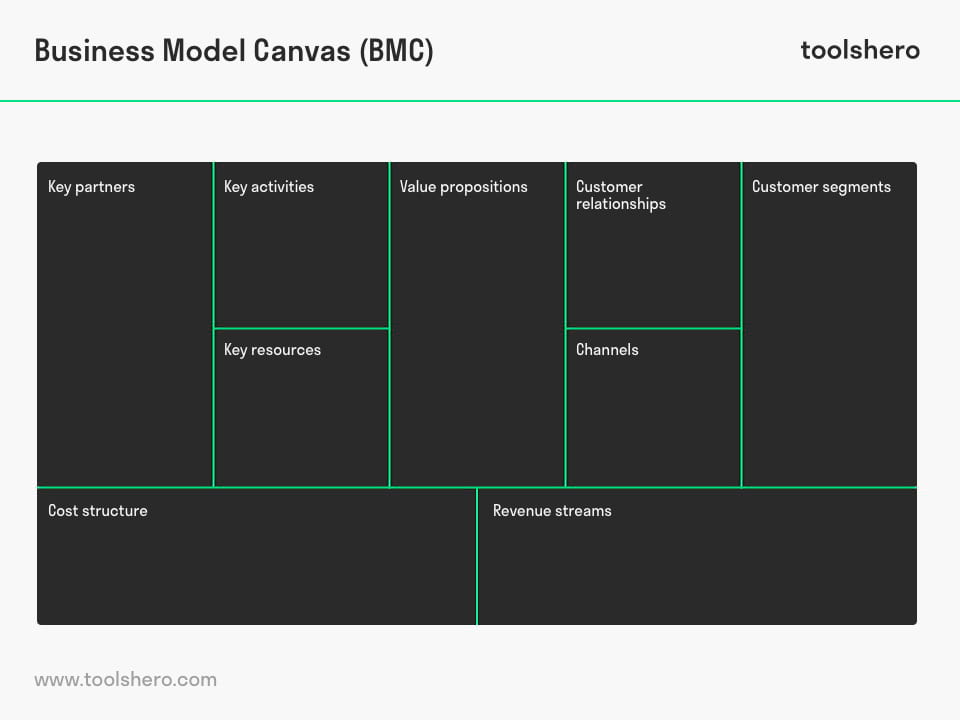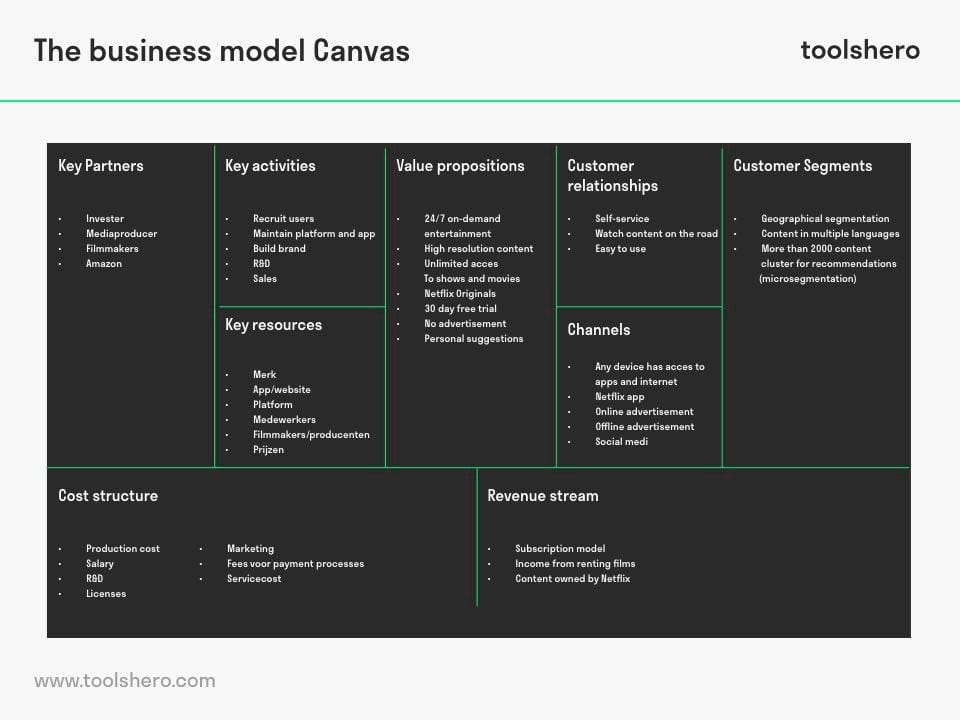Business Model Canvas (BMC) explained including template

Business Model Canvas: this article describes the Business Model Canvas (BMC), developed by Alexander Osterwalder and Yves Pigneur in a practical way. This article contains the definition of the BMC model, an example and practical tips. The article also contains a downloadable and editable Business Model Canvas template.
What is the Business Model Canvas (BMC)?
The Business Model Canvas (BMC) is a strategic tool for organizations. It is also known as the BMC model. It is a graphic representation of a number of building blocks that represent the elements of an organization.
The BMC can be deployed as a strategy tool for the development of a new organization and business model innovation. It can also be used to analyse the (business) situation of an existing business.
The Business Model Canvas was developed by the Swiss business model guru Alexander Osterwalder and management Information Systems professor Yves Pigneur. They defined nine categories for the Business Model Canvas which they refer to as the building blocks of an organization.
The model was published in the book Business Model Generation (2010). The building block are:
- Key partners
- Key activities
- Key resources
- Value propositions
- Customer relationships
- Channels
- Customer segments
- Cost structure
- Revenue streams
The performance of an existing organization can easily be improved using the Business Model Canvas. All company aspects are made clear at a glance because of the visual aspect.
By looking at the developments per category, an organization can fine-tune its value proposition and structurally improve its strategy.
When setting up a new company clear decisions can be made in advance using the Business Model Canvas.

Figure 1 – Business Model Canvas (BMC)
1. Key partners
Key partnerships are placed on the left side of the canvas. For both start-up organizations and existing organizations it may be important to create alliances with partners. For instance when fighting the competition and combining knowledge and skillfulness.
Essential information will be acquired by knowing in advance which partners may constitute a valuable relationship.
2. Key activities
A good understanding of the value proposition can be obtained by having proper knowledge of the core activities of a company. This is not just about production. A problem-solving approach, networking and the quality of the product or service are important as well.
When the organization knows what the added value for the customer is, a better relationship may develop with existing customers. This may be helpful in the canvassing of new customers and makes it easier to keep the competition at bay.
3. Key resources
Resources are means that a company needs to perform. They can be categorized as physical, intellectual, financial or human resources.
Physical resources may include assets such as business equipment. Intellectual resources include among other things knowledge, brands and patents. The financial resources are related to funds flow and sources of income and human resources comprises the staffing aspect.
4. Value propositions
The value proposition is about the core of a company’s right to exist, it meets the customer’s need.
How does an organization distinguish itself from the competition? On the one hand, this distinction focuses on quantity such as price, service, speed and delivery conditions. On the other hand, it also focuses on quality including design, brand status and customer experience and satisfaction.
5. Customer relationships
It is essential to interact with customers. The broader the customer base the more important it is to divide your customers into different target groups. Each customer group has specific needs.
By foreseeing the customer needs, the organization invests in different customers. A good service will ensure good and stable customer relationships that will be ensured in the future.
6. Channels
An organization deals with communications, distribution and sales channels. It is not just about customer contact and the way in which an organization communicates with their customers. The purchase location and the delivery of the product and/or services provided are decisive elements in this.
Channels to customers have five different stages: awareness of the product, purchase, delivery, evaluation & satisfaction and after sales. It is advisable to combine offline and online channels to reach as many customers as possible.
7. Customer segments
As organizations often provide services to more than one customer group, it is sensible to divide them into customer segments.
Products and services can be better geared towards specific needs and requirements for each group. This can be done by identifying what those needs are and which value is attached to them. This will lead to greater customer satisfaction, which in turn will contribute to a good value proposition.
8. Cost structure
By gaining an insight into cost structure, an organization will know what the minimum turnover must be to make a profit.
The cost structure considers economies of scale, constant and variable costs and profit advantages. Costs have to be adjusted when it’s obvious that more investments must be made than the organization is generating in revenue. Often an organization will opt for deleting a number of key resources.
9. Revenue streams
In addition to the cost structure, the revenue streams will provide a clear insight into the revenue model of an organization. For example, how many customers does an organization need on an annual basis to generate a profit? How much revenue does it need to break even?
The revenue streams are cost drivers. Aside from the sale of goods, subscription fees, lease income, licensing, sponsoring and advertising may also be an option.
The power of brainstorming sessions
All members of the management team can make excellent contributions to the business model canvas. This can be done by filling it out on a large sheet of paper.
This way, all members can enjoy brainstorming sessions with each other, think about the categories and voice their opinions. This will create a good and objective image of the organization. Any new ideas can be discussed immediately and possibly be developed concretely.
Business Model Canvas example

Figure 2 – a example of a filled Business Model Canvas
Business Model Canvas Template
Start describing the different aspects of the Business Model Canvas with this ready to use Business Model Canvas template.
Download the Business Model Canvas Template
This template is exclusively for our paying Toolshero members. Click here to see if a membership is something for you!It’s Your Turn
What do you think? Is the Business Model Canvas applicable in today’s modern economy and business? Do you recognize the practical explanation or do you have more suggestions? What are your success factors for good business model canvas management?
Share your experience and knowledge in the comments box below.
More information
- Osterwalder, A. (2004). The business model ontology: A proposition in a design science approach.
- Osterwalder, A., & Pigneur, Y. (2013). Designing business models and similar strategic objects: the contribution of IS. Journal of the Association for Information Systems, 14(5), 237-244.
- Veyrat, P. (2017). Lean Business Model Canvas: For every type of organization.
- Osterwalder, A., & Pigneur, Y. (2010). Business model generation: a handbook for visionaries, game changers and challengers. John Wiley & Sons.
How to cite this article:
Mulder, P. (2017). Business Model Canvas (BMC). Retrieved [insert date] from Toolshero: https://www.toolshero.com/strategy/business-model-canvas/
Original publication date: 03/14/2017 | Last update: 11/13/2023
Add a link to this page on your website:
<a href=”https://www.toolshero.com/strategy/business-model-canvas/”>Toolshero: Business Model Canvas (BMC)</a>













11 responses to “Business Model Canvas (BMC) explained including template”
Salutations! Je pense que c’est l’une des informations les plus utiles pour mon entreprise. Je suis heureux de lire votre article. Merci de partager avec nous pour cet article.
Great article about an awesome tool! As a business model coach I use the Business Model Canvas almost daily with my clients! It is such a valuable tool if applied correctly.
Thank you for your comment and sharing your experience Matthias.
Thank you i am just getting the hang of it however i see the value in keeping it brief and impact-full. love it!
Thank you for your feedback Kevin. I am glad that you found the article helpful.
I’m trying to prepare an effective business model canvas for my school project and I’m having hard time on it. Being my first time and it’s not a organization yet so i don’t know what to fill in. Please i need assistance.
Hi Gareth,
It’s understandable that filling in a fictive BMC can be challenging. Perhaps you could brainstorm with a classmate to come up with ideas? What can be really helpful as well is creating a mind map. Hope this helps!
Best regards,
Tom
that’s great content, thanks for it
Awesome stuff. Good explanation of the business model canvas. Thanks a million!
Thank you for your comment, Ana.
Business model canvas if the tool being applied effective it enhance the organization to know their strength and weaknesses and be more productive.